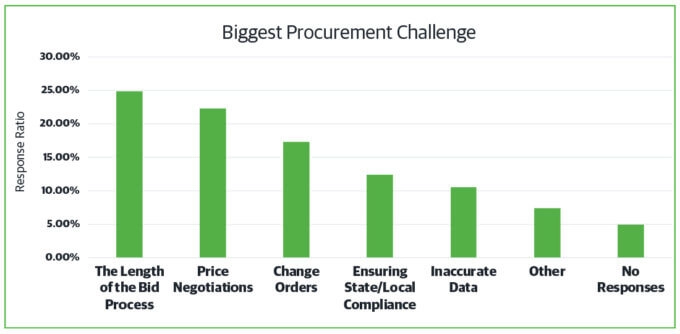Change is hard. Don’t agree? Drive to the nearest bookstore and check out the business section. At least one entire shelf will be dedicated to change management. And with all of the change right now amid the COVID-19 outbreak, you can bet the shelf is almost sold out. Change forces us to deviate from our plans and realign our expectations on the fly, often against our will. Making a change means we don’t get what we want when we want it. And nobody likes that.
This applies to hospital renovations and construction as well, where change orders can be a major frustration. We recently surveyed healthcare facilities professionals about the challenges and opportunities they’re facing in 2020. One thing we wanted to know was what their biggest challenge is when it comes to construction procurement. 17% said change orders give them the biggest headache.
Find out what else your peers are saying about managing and renovating healthcare facilities in our free eBook, “Vital Signs: The Status of Facilities in the Healthcare Industry.”
When Change Happens, Retreat is the Default Setting
Part of what makes change difficult is the fact that we all respond to it differently. We see this play out between facility owners and contractors often. Facility owners and contractors each bring different skillsets to the procurement relationship. While this is a good thing, it also means both will retreat to what they know best when confronted with change. Owners want to be good stewards of funding and may feel protective of their timeline and budget. Contractors, wanting to ensure they and their team are being fully compensated for their work, may tend to dig in for a fight.
This dynamic can lead to arguments, fights and plain old nastiness. Basically, each party retreats back to separate rooms and slams doors behind them. What’s unfortunate is that these situations can be avoided with good, open and honest communication. But it’s harder to talk openly when the two sides have competing priorities, and certain procurement methods can make it harder to meet in the middle.
When a low-bid method is utilized to procure construction, change order issues are more likely to arise. Don’t get it wrong — there is definitely a time and a need to use low bid methods. But anyone who has used it has battled with the change orders that tend to accompany that delivery method.
The nature of the delivery method does not allow for communication at the beginning of the project to help identify problems, resulting in change orders down the line. Instead of there being a cooperative, open conversation about the project plans, where potential hangups can be discussed, decisions are made purely on a basis of cost, leaving important questions unanswered.
Plus, there aren’t effective ways to deal with the negative impacts of change orders, like time delays and cost overruns. If healthcare project owners want to eliminate change orders, the best way to do that is to change from the low-bid method to a more flexible form of procurement, like Job Order Contracting (JOC).
If healthcare project owners want to eliminate change orders, the best way to do that is to change from the low-bid method to a more flexible form of procurement, like Job Order Contracting (JOC).
Dodging Change Orders with an Alternative Procurement Method
With Job Order Contracting, firm, preset prices are placed on the construction tasks included in your project’s Detailed Scope of Work. These prices are derived by selecting tasks from a Construction Task Catalog (CTC) to develop the contractor’s Price Proposal. The Price Proposal is the actual cost to do the agreed-upon Scope of Work. All the facility owner has to do is issue a “lump sum” purchase order and the contractor gets to work. So how does this alleviate the headaches of change orders?
Let’s say a hospital wants to renovate half of an outdated department floor. The owner and contractor walk through the floor and the owner points out everything to be completed: paint, new ceiling tile, new floor and cover base, updated wiring for new technologies, etc. The contractor then builds their Price Proposal from tasks in the CTC and delivers it to the facility owner, along with a Detailed Scope of Work outlining the work requested. The facility owner and a Gordian representative review the Price Proposal together and agree that it’s in line with the Detailed Scope of Work. The owner issues a Job Order and the contractor immediately gets to work.
But, in the middle of the project, the owner comes to the contractor and asks that they go ahead and renovate the entire floor, instead of just half. The contractor agrees, but realizes that doing so will require rerouting a gas line. Neither of these conditions were included in the original Detailed Scope of Work. So what happens?
With JOC, every supplemental Job Order is priced out of the Construction Task Catalog, just as the first Price Proposal was. To break that down, the cost to demo out the gas line remains the same if the contractor finds it in the middle of construction or during the initial job walk. If the CTC says it costs $1.05 a linear foot to demo the gas line, that’s what the contractor is paid. The same is true for the additional square footage. Whatever price was agreed to at the start of the project still stands.
With JOC, every supplemental Job Order is priced out of the Construction Task Catalog, just as the first Price Proposal was. Whatever price was agreed to at the start of the project still stands.
This means there is no project stoppage while the details of the supplemental orders are worked out. With JOC, the contractor simply delivers the facility owner another Price Proposal, and the owner issues another Job Order. Work continues without delay. Both the facility owner and JOC contractor are protected by the firm prices in the CTC, which can’t be changed. Since every change order is priced the same as the original Price Proposal, contractors can’t use change orders increase profit margins later in the project, and owners can’t hold the contractor’s feet to the fire down the road if the contractor encounters unforeseen circumstances.
Effective construction work requires communication and trust between the facility owner and contractor’s team. But, even when great working relationships are present, change orders can derail projects and cause tension. If you’re doing battle with change orders in your construction projects, then why not take a look into a procurement method designed to minimize them?







